CAA News Today
News from the Art and Academic Worlds
posted by Christopher Howard — May 17, 2017
Each week CAA News summarizes eight articles, published around the web, that CAA members may find interesting and useful in their professional and creative lives.
Damien Hirst Show Sparks Accusations of Cultural Appropriation
Damien Hirst launched his first major show of new works in ten years earlier this month in Venice, shortly ahead of the opening of the Venice Biennale. But along with massive crowds, Treasures from the Wreck of the Unbelievable is attracting charges of cultural appropriation, with one of Hirst’s sculptures replicating a Nigerian work from the fourteenth century without proper historical context. (Read more from Artsy.)
Cultural Appropriation and the Privilege of Creative Assumption
When the Canadian writer W. P. Kinsella died last year at age 81, many laudatory obituaries politely noted that he had been the subject of controversy involving cultural appropriation in the 1980s. Critics, both white and Indigenous, had objected vociferously to Kinsella’s “Indian” stories, in which the writer used a first-person narrator to tell funny tales of reserve life that included bumbling white bureaucrats and native tricksters. (Read more from the Globe and Mail.)
Words Fly on Free-Speech Bill
Numerous states are considering legislation designed to ensure free speech on college campuses, following violent protests over speakers at the University of California, Berkeley, and Middlebury College. Some of the bills would, controversially, mandate punishing students who disrupt campus speakers and require institutions to keep mum on political issues—and perhaps nowhere has the debate been as contentious as in Wisconsin. (Read more from Inside Higher Ed.)
Student Rights and the Role of Faculty
Despite the few reasonable similarities between students and customers, it’s still a hair-raising comparison for most faculty. I wonder if we might look at the issue more constructively by considering it from the vantage of student rights. (Read more from Faculty Focus.)
For Robert Rauschenberg, No Artist Is an Island
We tend to think of artists as natural loners, off in their studios, wrestling with their inner selves. But Robert Rauschenberg: Among Friends, which opens soon at the Museum of Modern Art, points us in a different direction. It situates Rauschenberg’s work amid that of two dozen fellow artists who provided an audience for one another in New York City during the 1950s and 1960s. (Read more from the New York Times.)
The Arts Brand
“Branding” is a somewhat confusing topic. Briefly, our “brand” is the public’s awareness and perception of our organizations and the goods and services we offer. It is the sum of their perceptions and experiences and is created by all the various parts of our organizations. (Read more from Barry’s Blog.)
Demystifying the Journal Article
One of the most important parts of professionalization is publishing your research. Much of what I’ve learned about publishing comes from submitting papers to journals, incorporating reviewer comments, workshopping papers, and having conversations with colleagues and mentors. (Read more from Inside Higher Ed.)
Artists’ Commissions, Tech Gift, and Guns: The Legal Issues Facing US Museums
What’s keeping museum lawyers up at night? The new future. That was the message at the annual meeting of over two hundred museum professionals and lawyers in Dallas. They discussed how to stay out of trouble when commissioning installation and performance art, how to prepare for changes to US tax law, and how best to collaborate with technology companies. (Read more from the Art Newspaper.)
New in caa.reviews
posted by michaelh — May 12, 2017
John Hawley reviews Rembrandt’s First Masterpiece at the Morgan Library and Museum. The show provided “a rare opportunity to engage with Rembrandt’s painted Judas Returning the Thirty Pieces of Silver (1629) and the three surviving preparatory drawings associated with it.” Despite some “flaws in conception and execution,” the exhibition offered a “once-in-a-lifetime opportunity for visitors.” Read the full review at caa.reviews.
Laura Roulet visits Puerto Rican Light (Cueva Vientos) (2015), a site-specific installation created by Allora & Calzadilla and commissioned by the Dia Art Foundation. Set in a remote cave in Puerto Rico, the project “is a post-colonial inversion and commentary on the complicated state of U.S.-Puerto Rican relations” and “a way of putting Puerto Rico on the map for serious international art travelers.” Read the full review at caa.reviews.
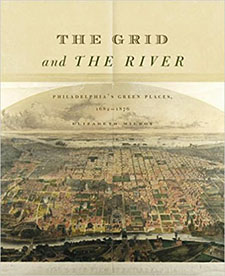 Eric Kramer reads The Grid and the River: Philadelphia’s Green Places, 1682–1876 by Elizabeth Milroy. An “authoritative and compelling portrait of how a city’s actual landscape fabric has been fashioned through a process of negotiating and representing a dominant idea about landscape’s place in American culture,” the volume builds “a more nuanced and positive image of how cities and landscapes coexist.”
Eric Kramer reads The Grid and the River: Philadelphia’s Green Places, 1682–1876 by Elizabeth Milroy. An “authoritative and compelling portrait of how a city’s actual landscape fabric has been fashioned through a process of negotiating and representing a dominant idea about landscape’s place in American culture,” the volume builds “a more nuanced and positive image of how cities and landscapes coexist.”
Through a generous grant from the Wyeth Foundation for American Art in 2014, CAA provided financial support for the publication of Elizabeth Murray’s The Grid and the River: Philadelphia’s Green Places, 1682–1876. Read the full review at caa.reviews.
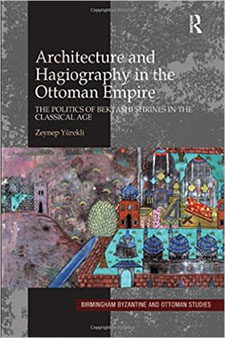 Maxime Durocher dicusses Zeynep Yürekli’s Architecture and Hagiography in the Ottoman Empire: The Politics of Bektashi Shrines in the Classical Age. “Combining a study of hagiographical texts with an advanced analysis of the sixteenth-century architectural transformation of two Anatolian shrines,” the author “provides an insightful study” that “contributes to the revival of Sufi studies.” Read the full review at caa.reviews.
Maxime Durocher dicusses Zeynep Yürekli’s Architecture and Hagiography in the Ottoman Empire: The Politics of Bektashi Shrines in the Classical Age. “Combining a study of hagiographical texts with an advanced analysis of the sixteenth-century architectural transformation of two Anatolian shrines,” the author “provides an insightful study” that “contributes to the revival of Sufi studies.” Read the full review at caa.reviews.CWA Picks for May 2017
posted by CAA — May 01, 2017
Each month, CAA’s Committee on Women in the Arts selects the best in feminist art and scholarship. The following exhibitions and events should not be missed.
Louise Lawler: A Movie Will Be Shown Without a Picture
Museum of Modern Art
11 W 53 Street, New York, NY
May 2 and 10, 2017
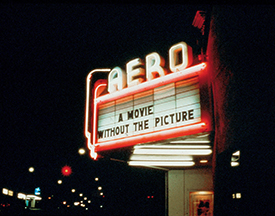
Marquee for A Movie Will Be Shown Without the Picture, Aero Theatre, Santa Monica, California, December 7, 1979 (photograph by Louise Lawler)
An appropriately deadpan announcement, now in the collection of the Metropolitan Museum of Art, for Louise Lawler’s cinematic event A Movie Will Be Shown Without A Picture (1979), reproduced the work’s title on a flat black card. Indeed, this is what viewers to the Aeron Theater in Santa Monica would have encountered on the night of Lawler’s event: a film shown without its flickering image. We might understand Lawler’s gesture as a riposte to Laura Mulvey’s influential text “Visual Pleasure and Narrative Cinema,” published five years before in the British film journal Screen. The filmic performance deprives audiences of the picture of the chosen film (the film changes with each iteration), instead asking them to rely on sound and soundtrack. Thus viewers are left to imagine and project their own fantasies (if they haven’t seen the film) or cobble together their memories of the film (if they have). As an arm of the programming for Louise Lawler’s retrospective at the Museum of Modern Art in New York, A Movie Will Be Shown Without a Picture will be screened two times.
Black Women Artists for Black Lives Matter
Project Row Houses
2521 Holman St., Houston, TX
March 25–June 4, 2017
Usually the curatorial and programming staff at Project Row Houses determine a theme and invite a series of artists to make installations and public programming inside the block of row houses in Houston’s Third Ward. This time Public Art Director Ryan Dennis and artist Simone Leigh cocurated the round to be exclusively for Black Women Artists for Black Lives Matter, a collective group that Leigh founded during her residency at the New Museum last year, and which now has chapters in London, Los Angeles, and Chicago. Performances, installations, platforms for dialogue and activation—these are the things that tie Project Row Houses and Black Women Artists for Black Lives Matter together. What began with an incubation period to get Houston’s chapter of BWA for BLM started, and was inaugurated with a processional performance, is now a full-tilt community platform for building generative ideas and actions for entering into the movement. As if to sum up the sentiments of the current round, one of the row houses is emblazoned with a supergraphic of the following sentiment: “YOU’VE GOTTA LOVE US OR LEAVE US ALONE.”
Katharina Fritsch: Multiples
Walker Art Museum
725 Vineland Place, Minneapolis, Minnesota
May 11–October 15, 2017
Katharina Fritsch’s sculpture, which seeks to defamiliarize the familiar and query the boundaries between the natural and the symbolic, will be on view at the Walker Art Museum for the next several months. Animals, religious figurines, body parts, and other objects drawn from the history and fairy tales of her native Germany take one new meanings when color, scale, and materials of everyday objects are altered. The show will include some forty objects, ranging from her early work as a student to her more recent pieces, drawn from the museum’s permanent collection. Katharina Fritsch: Multiples is a companion exhibition to the installation of her monumental, ultramarine blue Hahn/Cock in the Minneapolis Sculpture Garden in June. Described by the artist as “a feminist sculpture,” this work was first displayed on the fourth plinth in Trafalgar Square in the summer of 2013.
Musée Camille Claudel
Musée Camille Claudel
10, rue Gustave Flaubert, 10 400 Nogent-sur-Seine, France
Opened March 26, 2017
At long last, the beloved nineteenth-century French sculptor and feminist art icon Camille Claudel is receiving her due with a museum devoted to her work. Located in the small town of Nogent-sur-Seine, the Musée Camille Claudel is built around the family home where she spent her early adolescence. After a temporary exhibition of her work in 2003 brought over forty thousand visitors to Nogent-sur-Seine (pop. 6,000), it was determined that a museum dedicated to its most famous resident was in order. The Musée Camille Claudel now houses the world’s largest collection of the sculptor’s work. Visitors, who will be gratified to see such well-known pieces as The Waltz and The Gossips, will also be able to discover similarly remarkable works such as Abandon and Fortune. It takes under an hour by train to reach Nogent-sur-Seine from Paris.
Power: Work by African American Women from the Nineteenth Century to Now
Sprüth Magers
5900 Wilshire Blvd, Los Angeles, CA
March 29–June 10, 2017
The exhibition Power at Sprüth Magers features thirty-seven African American women artists from the nineteenth century until now. Works span fine-art and folk-art traditions covering multiple mediums, including painting, photography, video, sculpture, and installation. The title of the exhibition takes its name from a 1970 gospel song by Sister Gertrude Morgan, a self-taught, musician, poet, artist, and preacher. The works, engaging in issues of race, gender, and class, trace the threads of the craft-based folk traditions to a newer, academically trained generation of artists, depicting the “struggle to establish themselves as equal players on the uneven field of the American republic.”
In a review of the show published in the Los Angeles Times on April 11, 2017, the author Leah Ollman writes, “Artists here treat the physical body and the emblematic body of the nation as contested sites. Historical trauma persists within both, and both serve as ready—if not always willing—vehicles for self-determination.”
Artists in the exhibition, which was curated by Todd Levin, include: Beverly Buchanan, Elizabeth Catlett, Sonya Clark, Renee Cox, Njideka Akunyili Crosby, Karon Davis, Minnie Evans, Nona Faustine, LaToya Ruby Frazier, Ellen Gallagher, Leslie Hewitt, Clementine Hunter, Steffani Jemison, Jennie C. Jones, Simone Leigh, Julie Mehretu, Sister Gertrude Morgan, Senga Nengudi, Lorraine O’Grady, Sondra Perry, Howardena Pindell, Faith Ringgold, Betye Saar, Joyce J. Scott, Emmer Sewell, Ntozake Shange, Xaviera Simmons, Lorna Simpson, Shinique Smith, Renee Stout, Mickalene Thomas, Alma Woodsey Thomas, Rosie Lee Tompkins, Kara Walker, Meta Vaux Warrick Fuller, Carrie Mae Weems, and Brenna Youngblood.
Power will also include an installation of over one hundred African American vernacular photographs from the early twentieth century on loan from the Ralph DeLuca Collection. They offer a diverse view into everyday lives of African American women, from images of positive change to difficult scenes of negative stereotyping and violence. Offered as an exhibition-within-an-exhibition, these images from a century ago encourage reflection upon the continued struggles of black lives in America today.
We Wanted a Revolution: Black Radical Women, 1965–85
Brooklyn Museum
Elizabeth A. Sackler Center for Feminist Art and Stephanie and Tim Ingrassia Gallery of Contemporary Art, Fourth Floor, 200 Eastern Parkway, Brooklyn, New York
April 21–September 17, 2017
The exhibition We Wanted a Revolution: Black Radical Women, 1965–85 explores the intersections of avant-garde art worlds, radical political movements, and profound social change through photography, sculpture, printmaking, photography, performance, film, and video. Examining the political, social, cultural, and aesthetic priorities of women of color during the emergence of second-wave feminism, this exhibition is the first “to highlight the voices and experiences of women of color—distinct from the primarily white, middle-class mainstream feminist movement—in order to reorient conversations around race, feminism, political action, art production, and art history in this significant historical period.”
The artists represented in the exhibition include: Emma Amos, Camille Billops, Kay Brown, Vivian E. Browne, Linda Goode Bryant, Beverly Buchanan, Carole Byard, Elizabeth Catlett, Barbara Chase-Riboud, Ayoka Chenzira, Christine Choy and Susan Robeson, Blondell Cummings, Julie Dash, Pat Davis, Jeff Donaldson, Maren Hassinger, Janet Henry, Virginia Jaramillo, Jae Jarrell, Wadsworth Jarrell, Lisa Jones, Loïs Mailou Jones, Barbara Jones-Hogu, Carolyn Lawrence, Samella Lewis, Dindga McCannon, Barbara McCullough, Ana Mendieta, Senga Nengudi, Lorraine O’Grady, Howardena Pindell, Faith Ringgold, Alva Rogers, Alison Saar, Betye Saar, Coreen Simpson, Lorna Simpson, Ming Smith, and Carrie Mae Weems.
A host of events accompanied the exhibition. In addition to the DJ reception on April 20, which paid tribute to the revolutionary music of black women, the week-long opening celebration also included a symposium on April 21, a Julie Dash film marathon on April 22, and a Black Lunch Table on April 23.
We Wanted a Revolution, organized by Catherine Morris, Sackler Family Senior Curator for the Elizabeth A. Sackler Center for Feminist Art, and Rujeko Hockley, former assistant curator of contemporary art at the Brooklyn Museum, is part of A Year of Yes: Reimagining Feminism at the Brooklyn Museum, a yearlong series of exhibitions celebrating the tenth anniversary of the Elizabeth A. Sackler Center for Feminist Art.
CAA Members among the 2017–18 Rome Prize Winners
posted by CAA — Apr 28, 2017
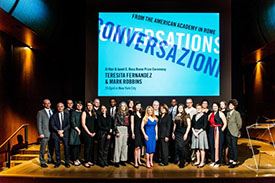 The American Academy in Rome has announced the recipients of its 2017–18 fellowships. The following CAA members are among the newest group of talented artists, scholars, writers, and composers chosen by the academy.
The American Academy in Rome has announced the recipients of its 2017–18 fellowships. The following CAA members are among the newest group of talented artists, scholars, writers, and composers chosen by the academy.
- Charles K. Williams II Rome Prize: Lisa Deleonardis, Austen-Stokes Professor, Department of the History of Art, Johns Hopkins University, “A Transatlantic Response to Worlds That Shake: Jesuit Contributions to Anti-Seismic Building Design in Early Modern Italy and Peru”
- Millicent Mercer Johnsen Post-Doctoral Rome Prize: Bissera V. Pentcheva, Professor, Department of Art History, Stanford University, “Animation in Medieval Art”
- Phyllis W. G. Gordan/Lily Auchincloss/Samuel H. Kress Foundation Pre-Doctoral Rome Prize: Joseph Williams, PhD Candidate, Department of Art, Art History, and Visual Studies, Duke University, “The Practice and Production of Architecture during the Mediterranean Commercial Revolution: The Church of S. Corrado in Moletta (ca. 1185–1303)”
- Andrew W. Mellon Foundation/National Endowment for the Humanities Post-Doctoral Rome Prize: Leslie Cozzi, Curatorial Associate, Hammer Museum, “Fra: Relation and Collaboration in Contemporary Italian Art”
- American Academy in Rome—Rome Prize: Cécile Fromont, Assistant Professor, Department of Art History, University of Chicago, “Images on a Mission: Cross-Cultural Encounters and Visual Mediation in Early Modern Kongo and Angola”
For over a century, the American Academy in Rome has awarded the Rome Prize to support innovative and cross-disciplinary work in the arts and humanities. Rome Prize fellowships include a stipend, room and board, and an individual work space at the institute’s eleven-acre campus in Rome.
New in caa.reviews
posted by CAA — Apr 28, 2017
Alise Tifentale reviews Anri Sala: Answer Me, an exhibition and catalogue organized by the New Museum. As the Albanian artist’s “first comprehensive survey exhibition in the United States,” the show primarily features video and sound works and “introduces Sala’s artistic strategies that often are aimed at multisensory confusion and a questioning of temporal and spatial coherence.” Read the full review at caa.reviews.
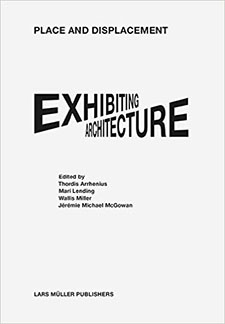 Nikolas Drosos reads Place and Displacement: Exhibiting Architecture, an edited collection of fifteen essays. Focusing on “the institutional structures that underpin architectural practice, theoretical discourse and its dissemination, as well as architecture’s relationship to its publics and to mass media,” the volume “reflects a greater tendency in scholarship to focus less on individual buildings.” Read the full review at caa.reviews.
Nikolas Drosos reads Place and Displacement: Exhibiting Architecture, an edited collection of fifteen essays. Focusing on “the institutional structures that underpin architectural practice, theoretical discourse and its dissemination, as well as architecture’s relationship to its publics and to mass media,” the volume “reflects a greater tendency in scholarship to focus less on individual buildings.” Read the full review at caa.reviews.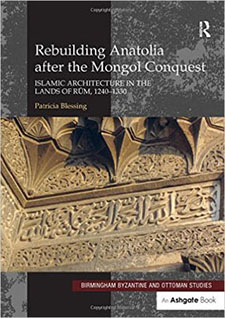 Christiana Maranci discusses Rebuilding Anatolia after the Mongol Conquest: Islamic Architecture in the Lands of Rūm by Patricia Blessing. The author “emphasizes the local circumstances in which the monuments were produced” and “argues that the lack of centralized control in Anatolia led … to a diverse and dynamic tradition best understood on its own terms.” Read the full review at caa.reviews.
Christiana Maranci discusses Rebuilding Anatolia after the Mongol Conquest: Islamic Architecture in the Lands of Rūm by Patricia Blessing. The author “emphasizes the local circumstances in which the monuments were produced” and “argues that the lack of centralized control in Anatolia led … to a diverse and dynamic tradition best understood on its own terms.” Read the full review at caa.reviews.
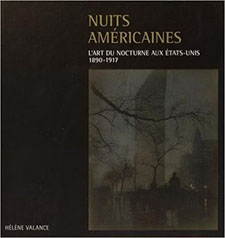 William Sharpe examines Hélène Valance’s Nuits américaines: L’art du nocturne aux États-Unis, 1890–1917. This “much-needed history” shows “how image makers reacted to the ways in which the American night was lit, exploited, and commercialized from the turn of the twentieth-century until the U.S. entry into World War I,” often in relation to “aesthetic, racial, imperial, and economic interests.” Read the full review at caa.reviews.
William Sharpe examines Hélène Valance’s Nuits américaines: L’art du nocturne aux États-Unis, 1890–1917. This “much-needed history” shows “how image makers reacted to the ways in which the American night was lit, exploited, and commercialized from the turn of the twentieth-century until the U.S. entry into World War I,” often in relation to “aesthetic, racial, imperial, and economic interests.” Read the full review at caa.reviews.New in caa.reviews
posted by CAA — Apr 21, 2017
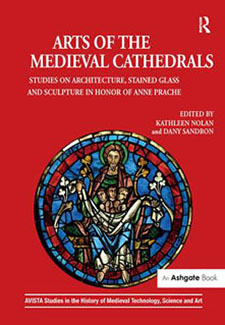 Evelyn Staudinger reviews Arts of the Medieval Cathedrals: Studies on Architecture, Stained Glass and Sculpture in Honor of Anne Prache, edited by Kathleen Nolan and Dany Sandron. The essays “honor the Sorbonne professor’s rich contributions to medieval art and architecture.” Covering a wide variety of topics, “the editors and authors have done a fine job celebrating Prache’s great intellectual acumen, diplomatic gifts, and warmth as a human being, while leaving behind erudite ‘memories’ and a wealth of new ideas.” Read the full review at caa.reviews.
Evelyn Staudinger reviews Arts of the Medieval Cathedrals: Studies on Architecture, Stained Glass and Sculpture in Honor of Anne Prache, edited by Kathleen Nolan and Dany Sandron. The essays “honor the Sorbonne professor’s rich contributions to medieval art and architecture.” Covering a wide variety of topics, “the editors and authors have done a fine job celebrating Prache’s great intellectual acumen, diplomatic gifts, and warmth as a human being, while leaving behind erudite ‘memories’ and a wealth of new ideas.” Read the full review at caa.reviews.
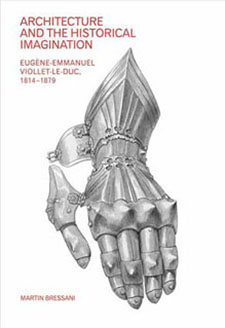 Jessica Basciano examines Architecture and the Historical Imagination: Eugène-Emmanuel Viollet-le-Duc, 1814–1879 by Martin Bressani. Viollet-le-Duc is “the nineteenth-century French architect, restorer, and theorist whose numerous and diverse activities continue to enthrall and perplex historians.” Although the “book’s complex arguments could be made clearer by offering more straightforward exposition,” “Bressani’s intellectual biography stands out in the landscape of Viollet-le-Duc studies because it offers a unified narrative based on the distinctive premise that the architect was motivated consistently by a form of pathological mourning.” Read the full review at caa.reviews.
Jessica Basciano examines Architecture and the Historical Imagination: Eugène-Emmanuel Viollet-le-Duc, 1814–1879 by Martin Bressani. Viollet-le-Duc is “the nineteenth-century French architect, restorer, and theorist whose numerous and diverse activities continue to enthrall and perplex historians.” Although the “book’s complex arguments could be made clearer by offering more straightforward exposition,” “Bressani’s intellectual biography stands out in the landscape of Viollet-le-Duc studies because it offers a unified narrative based on the distinctive premise that the architect was motivated consistently by a form of pathological mourning.” Read the full review at caa.reviews.
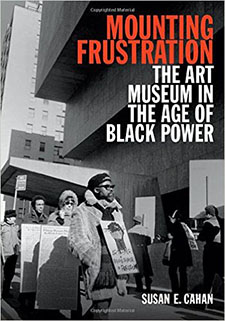 Anne Monahan reads Mounting Frustration: The Art Museum in the Age of Black Power by Susan E. Cahan. Framing her review with a discussion of recent police shootings of unarmed African American males and subsequent artists’ responses, Monahan presents Cahan’s “finely grained history of the New York art establishment’s attempts circa 1970 to reckon with African American representation.” Utilizing “close readings of archival documents, interviews, and secondary sources,” Cahan shows how demands by activists “conditioned the museums’ exhibition and hiring practices for decades thereafter.” Read the full review at caa.reviews.
Anne Monahan reads Mounting Frustration: The Art Museum in the Age of Black Power by Susan E. Cahan. Framing her review with a discussion of recent police shootings of unarmed African American males and subsequent artists’ responses, Monahan presents Cahan’s “finely grained history of the New York art establishment’s attempts circa 1970 to reckon with African American representation.” Utilizing “close readings of archival documents, interviews, and secondary sources,” Cahan shows how demands by activists “conditioned the museums’ exhibition and hiring practices for decades thereafter.” Read the full review at caa.reviews.
CAA Members Win NEH Summer Stipends
posted by CAA — Apr 13, 2017
 On March 29, the National Endowment for the Humanities (NEH) announced funding for 208 humanities projects totaling $21.7 million. These grants include programs that support international collaboration, engage students in interdisciplinary courses, and help veterans.
On March 29, the National Endowment for the Humanities (NEH) announced funding for 208 humanities projects totaling $21.7 million. These grants include programs that support international collaboration, engage students in interdisciplinary courses, and help veterans.
Among the recipients are the following CAA members, all of whom received a $6,000 Summer Stipend to work on their various research projects:
- Marie-Stéphanie Delamaire of the Winterthur Museum, Garden, and Library in Winterthur, Delaware, for “Diderot and d’Alembert’s Encyclopedia and the Color Printing Revolution: A Translation and Critical Study”
- Jennifer Germann of Ithaca College in Ithaca, New York, for “A Study of the Portrait of Dido Elizabeth Belle and Lady Elizabeth Murray, an 18th-century British Artwork”
- Laura Morowitz of Wagner College in Staten Island, New York, for “Art Exhibitions in Vienna, Austria, during the Nazi Occupation”
- Allie Terry-Fritsch from Bowling Green State University in Bowling Green, Ohio, for “Cosimo de’Medici, Fra Angelico, and the Public Library of San Marco”
- Anne Verplanck of Pennsylvania State University in Harrisburg for “The Business of Art: Transforming the Graphic Arts in an Age of Mechanical Reproduction”
These awards come just weeks after President Donald J. Trump’s administration released a budget proposal calling for the elimination of the NEH, the National Endowment for the Arts, the Department of Education’s international education programs, the Institute for Museums and Library Services, and the Woodrow Wilson International Center for Scholars.
Our attention now turns to Congress, which can fund these programs despite the administration’s proposals. We have been heartened that these programs—which have been supported by presidents of both parties—have seen growing support in Congress in recent years. Indeed, over the past two years, the Republican-controlled Congresses have supported increases for the NEH.
Join the caa.reviews Council of Field Editors
posted by CAA — Apr 12, 2017
caa.reviews invites nominations and self-nominations for individuals to join its Council of Field Editors, which commissions reviews within an area of expertise or geographic region, for a term ending June 30, 2020. An online journal, caa.reviews is devoted to reviewing books, museum exhibitions, and projects relevant to art history, visual studies, and the arts.
The journal seeks field editors for books in the following subject areas: digital humanities; Early Modern Iberian and Colonial Latin American Art; nineteenth-century art; and Early Modern and Southern European Art. The journal also seeks a field editor for exhibitions in the Northeast. Candidates may be artists, art or design historians, critics, curators, or other professionals in the visual arts; institutional affiliation is not required.
Working with the caa.reviews editor-in-chief, the editorial board, and CAA’s staff editor, each field editor selects content to be reviewed, commissions reviewers, and reviews manuscripts for publication. Field editors for books are expected to keep abreast of newly published and important books and related media in their fields of expertise, and field editors for exhibitions should be aware of current and upcoming exhibitions (and other related projects) in their geographic regions. The Council of Field Editors meets annually at the CAA Annual Conference. Field editors must pay travel and lodging expenses to attend the conference.
Candidates must be current CAA members and should not currently serve on the editorial board of a competitive journal or on another CAA editorial board or committee. Nominators should ascertain their nominee’s willingness to serve before submitting a name; self-nominations are also welcome. Please send a statement describing your interest in and qualifications for appointment, a CV, and your contact information to: caa.reviews Editorial Board, College Art Association, 50 Broadway, 21st Floor, New York, NY 10004; or email the documents to Deidre Thompson, CAA publications assistant. Deadline: May 1, 2017.
News from the Art and Academic Worlds
posted by Christopher Howard — Apr 12, 2017
Each week CAA News summarizes eight articles, published around the web, that CAA members may find interesting and useful in their professional and creative lives.
Artists Are Luring Their Peers and Predecessors Out of Obscurity and Back into the Spotlight
Beyond the economy of galleries, fairs, and auction rooms, there is an alternative artist-to-artist network rooted in relationships based on aesthetic influences and mutual appreciation. In recent years, artists with some degree of success and visibility have gone out of their way to bring attention to lesser-known peers and predecessors. (Read more from ARTnews.)
Eleven Female Art Professors and Teachers on Their Favorite Women Artists
Continuing the Cut’s series celebrating women in the arts and expanding on the National Museum of Women in the Arts’ social-media campaign to get their followers to name #5WomenArtists, New York has asked female art professors and teachers to name the woman artist they admire the most. (Read more from New York.)
How Art Has Depicted the Ideal Male Body throughout History
In the history of masculinity, it is money rather than muscle that tends to be articulated. Class or status has been the determining factor in the defining of male exemplars. Be it in the East or West, the epitome of a handsome man has generally been an idealized version of an upper-class individual, an archetype that has itself changed over time. (Read more from Artsy.)
Art History’s Image Problem
“If you are going to study sixteenth-century French art, more power to you. I support the arts … but you are not going to get a job,” declared Sam Clovis, Donald Trump’s campaign cochair in an interview last May. Clovis was outlining the would-be president’s education policy, and art history served as a prime example of the kind of major that student loans, he argued, should not underwrite. (Read more from Inside Higher Ed.)
More Vibrant Tales of Obsolete Pigments
After its first installment on obsolete pigments, Hyperallergic had only hit the tip of the curious history of vanished colors. Below are a few more pigments that have mostly gone out of favor, due to them being hazardous to the health of their manufacturers or artists, having a shortage of their weird material, or advances in technology replacing them with synthetics. (Read more from Hyperallergic.)
How a Browser Extension Could Shake Up Academic Publishing
The Gates Foundation started its own open-access publishing platform, which the European Commission may replicate. The Open Access Button, a tool that helps researchers gain free access to articles, will be integrated into existing interlibrary-loan arrangements. Another initiative, called Unpaywall, is a simple browser extension that could help alter the status quo of scholarly publishing. (Read more from the Chronicle of Higher Education.)
Understanding Our Strengths and Weaknesses as Teachers
Every teacher has strengths and weaknesses. Have you ever tried to list yours? Doing so is a worthwhile activity. I’d recommend doing it in private with a favorite libation—only one, because there is a need to be thoughtful and honest. (Read more from Faculty Focus.)
Interviewing for New Hires
Because our organizations are small, vertical promotion is often difficult, if not impossible. Today, it is more common for younger people to expect to have multiple jobs at an ever earlier stage of their careers. Finding the right people for open positions in a highly competitive job market is critical to our success as organizations. (Read more from Barry’s Blog.)
Books Published by CAA Members
posted by CAA — Apr 04, 2017
Publishing a book is a major milestone for artists and scholars—browse a list of recent titles below.
Books Published by CAA Members appears every two months: in February, April, June, August, October, and December. To learn more about submitting a listing, please follow the instructions on the main Member News page.
April 2017
Flora Brooke Anthony. Foreigners in Ancient Egypt: Theban Tomb Paintings from the Early Eighteenth Dynasty (1550–1372 BC) (New York: Bloomsbury Academic, 2017).
Jacki Apple. Yoshio Ikezaki: Elements 1991–2016 (Pasadena, CA: Art Center College of Design, 2017).
Caroline Boyle-Turner. Paul Gauguin and the Marquesas: Paradise Found? (Pont-Aven, France: Éditions Vagamundo, 2016).
Shira Brisman. Albrecht Dürer and the Epistolary Mode of Address (Chicago: University of Chicago Press, 2016).
John Chaich and Todd Oldham. Queer Threads: Crafting Identity and Community (New York: AMMO Books, 2017).
Christine Filippone. Science, Technology, and Utopias: Women Artists and Cold War America (New York: Routledge, 2017).
Leonard Folgarait. Painting 1909: Pablo Picasso, Gertrude Stein, Henri Bergson, Comics, Albert Einstein, and Anarchy (New Haven: Yale University Press, 2017).
Elisabeth A. Fraser. Mediterranean Encounters: Artists between Europe and the Ottoman Empire, 1774–1839 (University Park: Pennsylvania State University Press, 2017).
Francesca Granata, Experimental Fashion: Performance Art, Carnival, and the Grotesque Body (London: I. B. Tauris, 2017).
Ray Hernández-Durán. The Academy of San Carlos and Mexican Art History: Politics, History, and Art in Nineteenth-Century Mexico (New York: Routledge, 2016).
Namiko Kunimoto. The Stakes of Exposure: Anxious Bodies in Postwar Japanese Art (Minneapolis: University of Minnesota Press, 2017).
Catha Paquette. At the Crossroads: Diego Rivera and His Patrons at MoMA, Rockefeller Center, and the Palace of Fine Arts (Austin: University of Texas Press, 2017).
Elizabeth Prettejohn and Peter Trippi, eds. Lawrence Alma-Tadema: At Home in Antiquity (New York: Prestel, 2016).
Sarahh E. M. Scher and Billie J. A. Follensbee, eds. Dressing the Part: Power Dress, Gender, and Representation in the Pre-Columbian Americas (Gainesville: University Press of Florida, 2017).
Jane A. Sharp, ed. Thinking Pictures: The Visual Field of Moscow Conceptualism (New Brunswick, NJ: Zimmerli Art Museum, 2016).
Tanya Sheehan, ed. Grove Art Guide to Photography (New York: Oxford University Press, 2017).
Victoria Surliuga. Ezio Gribaudo: The Man in the Middle of Modernism (New York: Glitterati, 2016).
Andrés Mario Zervigón. Photography and Germany (London: Reaktion Books, 2017).



































